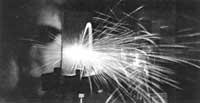Longer duration of compact discs
1992/10/01 Elhuyar Zientzia Iturria: Elhuyar aldizkaria
The Japanese company SONY, in its laser research, claims to break a barrier that until now was insurmountable: it has found a semiconductor laser that emits blue light. Thanks to the small wavelength of blue light, the laser can produce a fine light beam that will triple what can be stored on the compact disc.
Scientists from the USA, Europe and Japan have spent time searching for the blue light laser. Readers' red laser beam for compact discs is from Indian and Galio Phosphide, but last year the American 3M company developed a green light laser with a wavelength lower than that of red light.

Andrew House from SONY says that 20 months ago the research companies knew that blue light could be taken out of the Selenium cadmium. However, the SONY blue light laser is based on seleniurs.
Like all laser semiconductors, this laser is shaped like a multilayer sandwich with an active layer of 48 nanometer-wide selenium zinc in the center. On each side of the active layer are the layers of zinc, magnesium and sulfur selenide. One of them, type n, is doped with impurities that enriches it with the electron and the other, type p, is doped with impurities that eliminate electrons (therefore create holes).
When the electrons of the type n layer find holes of the type p layer, energy is emitted. The problem lies in the emission of this energy as a laser beam and not as heat. The higher the heat emitted, the lower the laser performance. SONY has said nothing about the performance of its laser.
Now the semiconductor must cool in liquid nitrogen up to -196°C. Therefore, until the necessary properties are reached at room temperature it will not be known if this new discovery can be used on compact discs.

Gai honi buruzko eduki gehiago
Elhuyarrek garatutako teknologia




